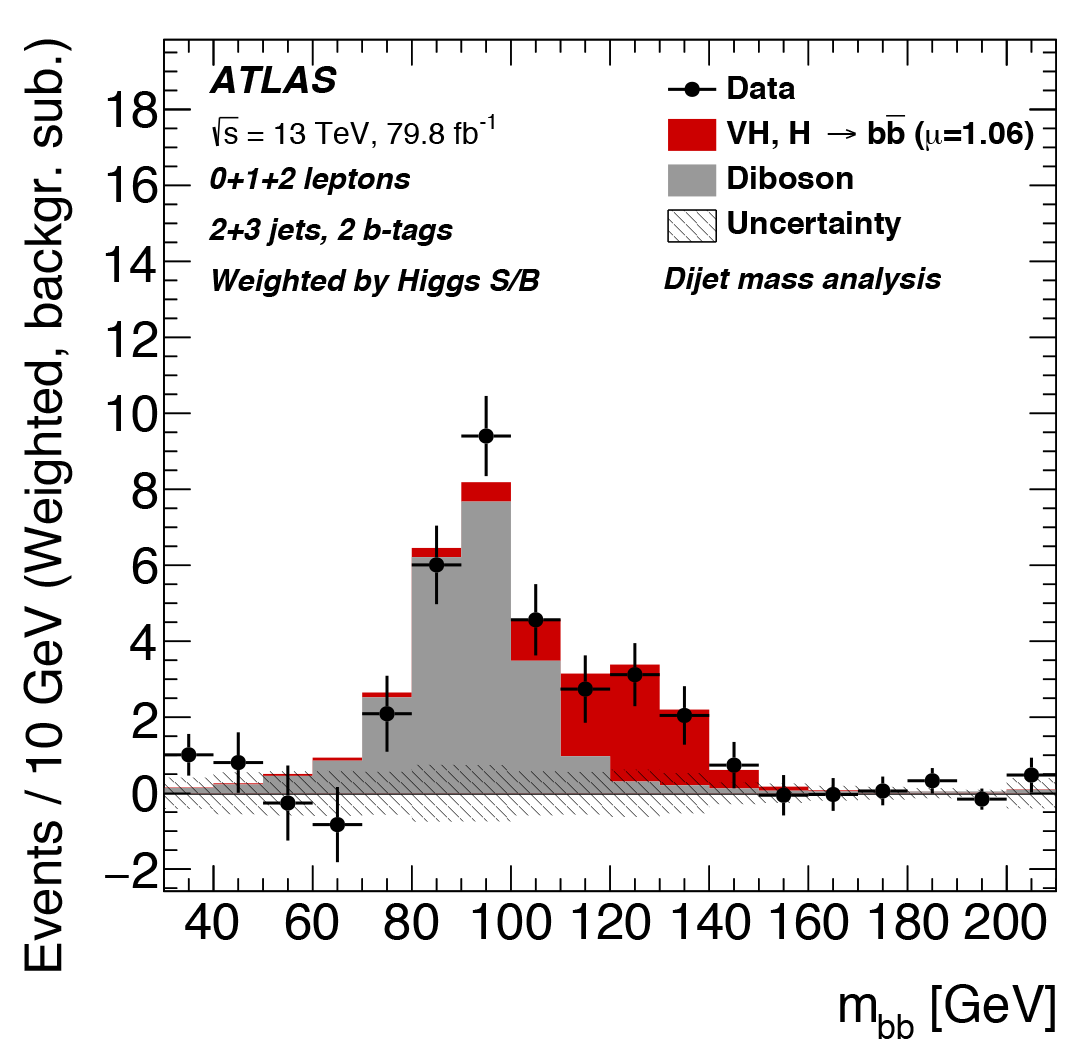ATLAS observes elusive Higgs boson decay to a pair of bottom quarks
28 August 2018 | By

Geneva, 28 August 2018. The ATLAS Collaboration at CERN’s Large Hadron Collider (LHC) has – at long last – observed the Higgs boson decaying into a pair of bottom (b) quarks. This elusive interaction is predicted to make up almost 60% of the Higgs boson decays and is thus primarily responsible for the Higgs natural width. Yet it took over six years after the 2012 discovery of the Higgs boson to accomplish this observation.
“ATLAS is proud to announce the observation of this important and challenging Higgs boson decay," says Karl Jakobs, ATLAS Spokesperson. “While the result is certainly a confirmation of the Standard Model, it is equally a triumph for our analysis teams. During the early preparations of the LHC, there were doubts on whether this observation could be achieved. Our success is thanks to the excellent performance of the LHC and the ATLAS detector, and the application of highly sophisticated analysis techniques to our large dataset.”
The ATLAS Collaboration first presented a preliminary result of this observation on 9 July at the 2018 International Conference on High-Energy Physics (ICHEP) in Seoul. Today, in a seminar together with the CMS Collaboration, ATLAS presented results which have been submitted for publication to Physics Letters B. They are based on combined Run 2 and Run 1 data, and utilise machine learning technology and new analysis techniques to reach a significance of 5.4 standard deviations.[1]
This elusive interaction is predicted to make up almost 60% of the Higgs boson decays and is thus primarily responsible for the Higgs natural width.

This is among the most demanding analyses carried out by ATLAS so far. “LHC collisions produce b-quark pairs in great abundance, making it hard to spot those originating from Higgs boson decays,” says Kerstin Tackmann, ATLAS Higgs working group convenor. “The analysis teams therefore focused on signatures, in particular the production of a Higgs boson in association with a vector boson, which increased substantially the purity of the signal.” This technique proved highly successful.
Today’s announcement is a new confirmation of the so-called “Yukawa couplings”. Similar to the Higgs mechanism, these couplings to the Higgs field provide mass to charged fermions (quarks and leptons), which are the building blocks of matter. Combined analyses of the Run 1 and Run 2 datasets have resulted in the first measurements of these couplings, as seen in the recent ATLAS observation of Higgs boson production in association with a top-quark pair and the observation of the Higgs boson decaying into pairs of tau leptons.
The new ATLAS result also establishes, for the first time, the production of a Higgs boson in association with a vector boson above 5 standard deviations. ATLAS has now observed all four main production modes of the Higgs boson, two of which this year.
These observations mark a new milestone in the study of the Higgs boson, as ATLAS transitions from observations to precise measurements of its properties. “We now have the opportunity to study the Higgs boson in unprecedented detail and will be able to further challenge the Standard Model,” concludes Karl Jakobs.
[1] Physicists consider five standard deviations (or “sigma”) the significance threshold past which they claim a discovery. There is only a one in a 3.5 million chance that such a signal originates from a statistical fluctuation of the background.
Learn more:
- Observation of H→bb decays and VH production with the ATLAS detector (arXiv: 1808.08238, submitted to Phys. Lett. B.)
- CERN Press Release: Long-sought decay of Higgs boson observed
- LHC Seminar: Observation of the H→bb decay at ATLAS and CMS (Watch the webcast live.)
- ATLAS Physics Briefing: Higgs boson observed decaying to b quarks – at last!
- CMS Collaboration: Observation of Higgs boson decay to bottom quarks (arXiv: 1808.08242)
- See also the full lists of ATLAS Physics Papers and ATLAS Conference Notes.



